| Jay | |
|---|---|

| |
| Eurasian jay (Garrulus glandarius) | |
| Scientific classification | |
| Domain: | Eukaryota |
| Kingdom: | Animalia |
| Phylum: | Chordata |
| Class: | Aves |
| Order: | Passeriformes |
| Superfamily: | Corvoidea |
| Family: | Corvidae |
| Genera | |
A jay is a member of a number of species of medium-sized, usually colorful and noisy, passerine birds in the crow family, Corvidae. The evolutionary relationships between the jays and the magpies are rather complex. For example, the Eurasian magpie seems more closely related to the Eurasian jay than to the East Asian blue and green magpies, whereas the blue jay is not closely related to either. The Eurasian jay distributes oak acorns, contributing to the growth of oak woodlands over time.
Systematics and species
Jays are not a monophyletic group. Anatomical and molecular evidence indicates they can be divided into a New World and an Old World lineage (the latter including the ground jays and the piapiac), while the grey jays of the genus Perisoreus form a group of their own. The black magpies, formerly believed to be related to jays, are classified as treepies.
Old World ("brown") jays
| Image | Genus | Living species |
|---|---|---|
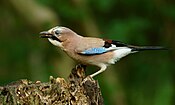 |
Garrulus Brisson, 1760 |
|
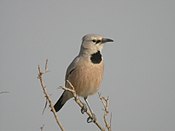 |
Podoces Fischer von Waldheim, 1821 - Ground jays |
|
 |
Ptilostomus Swainson, 1837 |
|
Grey jays
| Image | Genus | Living species |
|---|---|---|
 |
Perisoreus Bonaparte, 1831 - Grey jays |
|
New World jays
| Image | Genus | Living species |
|---|---|---|
 |
Aphelocoma Cabanis, 1851 - Scrub-jays |
|
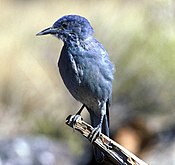 |
Gymnorhinus Wied-Neuwied, 1841 |
|
 |
Cyanocitta Strickland, 1845 |
|
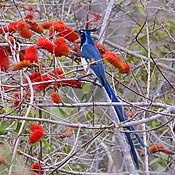 |
Calocitta G.R. Gray, 1841 - Magpie-jays |
|
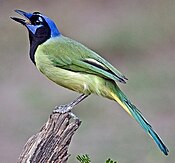 |
Cyanocorax F. Boie, 1826 |
|
 |
Cyanolyca Cabanis, 1851 |
|
In culture
Slang
The word jay has an archaic meaning in American slang meaning a person who chatters impertinently.
The term jaywalking was coined in the first decade of the 1900s to label persons crossing a busy street carelessly and becoming a traffic hazard. The term began to imply recklessness or impertinent behavior as the convention became established.
In January 2014, Canadian author Robert Joseph Greene embarked on a lobbying campaign among ornithologists in Europe and North America to get Merriam-Websters Dictionary to have a "Jabber of Jays" as an official term under bird groups.
References
- Ericson, Per G. P.; Jansén, Anna-Lee; Johansson, Ulf S.; Ekman, Jan (May 2005). "Inter-generic relationships of the crows, jays, magpies and allied groups (Aves: Corvidae) based on nucleotide sequence data". Journal of Avian Biology. 36 (3): 222–234. CiteSeerX 10.1.1.493.5531. doi:10.1111/j.0908-8857.2001.03409.x.http://www.nrm.se/download/18.4e32c81078a8d9249800021299/Corvidae%5B1%5D.pdf Archived 2017-08-10 at the Wayback Machine PDF fulltext
- "Jay". freedictionary.com.
An overly talkative person; a chatterbox.
- "Definition of Jay by Merriam-Webster". Merriam-Webster, Inc. 26 October 2024.
- "Definition of Jaywalker by Merriam-Webster". Merriam-Webster, Inc. 28 August 2024.
- "jay-walker". Oxford English Dictionary (Online ed.). Oxford University Press. (Subscription or participating institution membership required.)
- "Writer lobbies for new word to describe jays". Vancouver Courier. January 2, 2014. Retrieved January 2, 2014.
- "British Ornithologists' Union: What say ye countrymen to a jabber of jays?". Community News. January 6, 2014. Retrieved January 6, 2014.
External links
- "Blue Jay - Cyanocitta cristata videos". The Internet Bird Collection + The Macaulay Library.
 Texts on Wikisource:
Texts on Wikisource:
- "Jay". Collier's New Encyclopedia. 1921.
- "Jays". Encyclopedia Americana. 1920.
- "Jay". The New Student's Reference Work. 1914.
- Newton, Alfred (1911). "Jay". Encyclopædia Britannica (11th ed.).
- "Jay". New International Encyclopedia. 1905.
- Newton, Alfred (1881). "Jay". Encyclopædia Britannica. Vol. 13 (9th ed.).